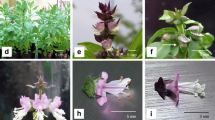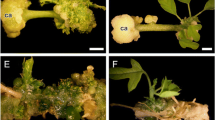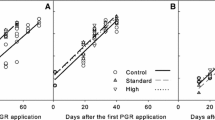Summary
Flower buds and anthers of the short-day plant Pharbitis nil were treated either with thermic shock (7 or 35°C) or osmotic/trophic shock (12% sucrose) for 24 h. Explants were transferred either to Murashige and Skoog medium (MS) with addition of 6-benzylaminopurine (BA; 4.4μM) and 6% sucrose or to the same growth medium containing 22 μM BA and 3% sucrose. Both media were supplemented with α-naphthaleneacetic acid (NAA; 0.55 μM). Osmotic/trophic shock stimulated the occurrence of shoots on flower buds grown on medium containing 22 μM BA. Thermic shock (7 and 35°C) inhibited this process on both types of explants. Regenerated plantlets were transferred to MS medium supplemented with 6% sucrose, gibberellic acid (GA3; 1.44μM), NAA (0.55 μM) and Ca2+ (0.66 mgl−1). After 3–4 wk they were able to produce flowers without photoperiodic induction.
Similar content being viewed by others
References
Almeida, M. D.; Kerbauy, G. B. Micropropagation of Bactris gasipaes (Palmae) through flower bud culture. Revista Brasileira Fisiol. Veg. 8:215–217; 1996.
Feng, G. H.; Ouyang, J. The effects of KNO3 concentration in callus induction medium for wheat anther culture. Plant Cell Tiss. Organ. Cult. 12:3–12; 1987.
Flachsland, E.; Mrogiński, L.; Davina, J. Regeneration of plants from anthers of Stevia rebaudiana Bretoni (Compositae) cultivated in vitro. Biocell 20:87–90; 1996.
Fraser, L. G.; Harvey, C. F. Somatic embryogenesis from anther-derived callus in two Actinidia species. Sci. Hort. 29:335–346; 1986.
Jain, R. K.; Jain, S.; Wu, R. Stimulatory effect of water stress on plant regeneration in aromatic Indica rice varietes. Plant Cell Rep. 15:712–717; 1996.
Jeannin, G.; Bronner, R.; Hahne, G. Somatic embryogenesis and organogenesis induced on the immature zygotic embryo of sunflower (Helianthus annuus L.) cultivated in vitro: role of the sugar. Plant Cell Rep. 15:200–204; 1995.
Jia, S. R.; Chua, N. H. Somatic embryogenesis and plant regeneration from immature embryo culture of Pharbitis nil. Plant Sci. 87:215–223; 1992.
Johannson, L. B. Improved methods for induction of embryogenesis of anthers Solanum tuberosum. Potato Res. 29:179–190; 1986.
Johannson, L. B. Increased induction of embryogenesis and regeneration in anther cultures of Solanum tuberosum L. Potato Res. 31:145–149; 1988.
Laparra, H.; Bronner, R.; Hahne, G. Histological analysis of somatic embryogenesis induced in leaf explants of Helianthus smithii Heiser. Protoplasma 196:1–11; 1997.
Li, J., O'Neill, S. D. Somatic embryogenesis and regeneration in Pharbitis nil. Plant Physiol. 102:97(abstract 543): 1993.
Marcińska, I.; Dubert, F.; Biesaga-Kościelniak, J. Transfer of the ability to flower in winter wheat via callus tissue regenerated from immature inflorescences. Plant Cell Tiss. Organ Cult. 41:285–288; 1995.
Masuda, H.; Oohashi, S. Direct embryo formation from epidermal cells of carrot hypocotyls. J. Plant Physiol. 145:531–534; 1995.
Miller, R. M.; Kaul, V.; Hutchinson, J. F.; Maheswaran, G.; Richards, D. Shoot regeneration from fragmented flower buds of carnation Dianthus caryophyllus. Ann. Bot. 68:563–568; 1991.
Miyoshi, K. Callus induction and plantlet formation through culture of isolated microspores of eggplant (Solanum melongena L.) Plant Cell Rep. 15:391–395; 1996.
Murashige, T.; Skoog, F. A revised medium for rapid growth and bioassays with tobacco tissue cultures. Physiol. Plant. 15:473–497; 1962.
Patton, D. A.; Meinke, D. W. High-frequency plant regeneration from cultured cotyledons of Arabidopsis thaliana. Plant Cell Rep. 7:233–237; 1988.
Radke, S.; Turner, I. Transformation and regeneration of Brassica rapa using Agrobacterium tumefaciens. Plant Cell Rep. 11:499–505; 1992.
Rost, T. L.; Peterson, K. The developmental anatomy of adventive plantlets from leaves and leaf segments of Crassula argentea (Crassulaceae). Bot. Gaz. 137:203–210; 1976.
Rout, J. R., Sarma, N. P. High frequency plantlet regeneration in rice anther callus cultures. http://probe.nalusda.gov:8000/otherdoes/rgn/rgn3/v31X47.html; 1995.
Sangwan, R. S. Androgenic stimulating factors in the anther and isolated pollen grain culture of Datura innoxia Mill. J. Exp. Bot. 28:843–852; 1977.
Sangwan, R. S.; Norreel, B. Pollen embryogenesis in Pharbitis nil L. Naturwissenschaften 62:440; 1975.
Shimasaki, K.; Uemoto, S. Rhizome induction and plantlet regeneration of Cymbidium goeringii from flower bud cultures in vitro. Plant Cell Tiss. Organ Cult. 25:49–52; 1991.
Suh, S. K.; Park, H. G. Effects of temperature pretreatment, growth regulators' and antibiotic treatments on anther cultures of various cultivars of garlie (Allium sativum L.). J. Korean Soc. Hort. Sci. 35:337–344; 1994.
Torres, K. C. Tissue culture techniques for horticultural crops. New York: Van Nostrand Reinhold; 1989.
Trejgell, A.; Tretyn, A. Regeneration of Pharbitis nil from immature embryos by somatic embryogenesis. Acta Soc. Bot. Polon. 66:159–163; 1997.
Trejgell, A.; Tretyn, A.; Nicoś, D. Attempt at regeneration of Pharbitis nil from fragments of vegetative organs. Acta Physiol. Plant. 20:161–166; 1998.
Verron, P.; Le Nard, M.; Cohat, J. In vitro organogenic competence of different organs and tissues of lily of the valley ‘Grandiflora of Nantes’. Plant Cell Tiss. Organ Cult. 40:237–242; 1995.
Yang, Y.; Wada, K.; Futsuhara, Y. Comparative studies of organogenesis and plant regeneration in various soybean explants. Plant Sci. 72:101–109; 1990.
Zhao, J. P.; Simmonds, D. H.; Newcomb, W. High frequency production of doubled haploid plants of Brassica napus cv Topas derived from colchicine-induced microspore embryogenesis without heat shock. Plant Cell Rep. 15:668–671; 1996.
Author information
Authors and Affiliations
Corresponding author
Rights and permissions
About this article
Cite this article
Trejgell, A., Wójciak, A. & Tretyn, A. Photoperiodically independent flowering of Pharbitis nil plants regenerated from flower buds. In Vitro Cell.Dev.Biol.-Plant 38, 564–568 (2002). https://doi.org/10.1079/IVP2002351
Received:
Accepted:
Issue Date:
DOI: https://doi.org/10.1079/IVP2002351




